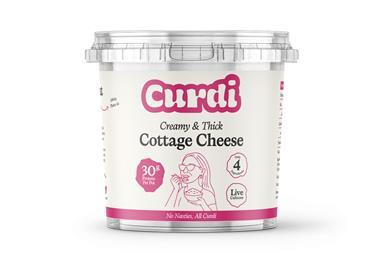As Spain, Italy and Greece sink into the mire, northern Europe is thriving. But not when it comes to cheese.
After volume sales of Continental cheese dipped by 0.3% last year, Brits have rediscovered their love of imports, sending sales up 4.9% year-on-year to 46,594 tonnes - and specialities from crisis-stricken southern Europe are proving especially popular [Kantar Worldpanel 52w/e 10 June 2012].
Volume sales of Greek Feta, Italian Grana Padano and Pecorino Romano, and Spanish Manchego have gone up by double-digits over the past year, while some northern European cheeses - especially from the Netherlands - have struggled.
So why is southern Europe having such a good run, and how can northern European cheesemakers fight back?
Counter-intuitively, the eurozone crisis has been good news for Continental cheese - it’s weakened the euro against the Pound, making cheeses cheaper to UK buyers. This obviously benefits all countries in the eurozone, but southern producers have been especially focused on turning this to their advantage. “The turmoil in Greece has encouraged cheesemakers to look abroad for growth opportunities,” says Neil Burchell, MD of Futura Foods, which recently launched a branded range of Greek cheeses under the name Yamas!
As southern Europeans look to sell more cheese to the UK, supermarket buyers are only too happy to oblige. “Cheese from Southern Mediterranean countries are proving very popular with our shoppers at the moment,” says Waitrose cheese buyer Chris Dawson. “There’s been a lot of NPD recently, and we’ve developed relationships with more Greek suppliers.”
The Italians, too, have bolstered relationships with UK mults. There is less demand in Italy for cheese because of the country’s turbulent economic climate, says Cesare Baldrighi, president of The Consortium for the Protection of the Grana Padano Cheese. “In Italy we have seen a decrease of 1% of the rate of consumption, while foreign markets are experiencing a growth rate of 2%.”
As a result, export destinations such as the UK have become more important for producers, with Grana up 22.1% in volume and 21.7% in value over the past 12 months, and mascarpone up 12.8% and 24.6% by value.
Southern European cheeses are doing well in the UK because Brits continue to be interested in Mediterranean cuisine, and cheeses marketed specifically for cooking are proving very popular, says Chris Chisnall, marketing director at cheese supplier Bradbury’s.
Yet despite strong sales, it has not all been plain sailing for the southern Europeans. With Greece’s economy perilously close to collapse, actually getting cheese to the UK has become increasingly difficult, says Burchell. And Italian cheesemakers were further hit in May, when earthquakes caused the loss of numerous wheels of Parmesan and Grana Padano. “This has affected stock levels of both cheeses, which in turn has affected the gross price,” says Baldrighi.
Away from the epicentre of the eurozone crisis, France has had a good year overall, with Brie and Camembert both putting in strong performances. It’s been tougher for some of the smaller cheeses, but that hasn’t dampened buyers’ enthusiasm for Gallic cheese, especially at the artisanal end. Booths launched a 10-strong range of French artisan cheeses just before Christmas and says sales have been “encouraging”.
“The turmoil in Greece has encouraged cheesemakers to look abroad for growth” Neil Burchell,Futura Foods
Tables turned for Northerners
For many northern European cheesemakers, meanwhile, the past 12 months have been a decidedly mixed bag. Danish Blue volumes have dropped by 8.6%, volumes of Edam are down 6.1%, while Leerdammer volumes have slumped by 19.8% - a complete reversal in fortunes for the cheese, which increased volume by 30.7% between 2010 and 2011.
Stephen Gregory, head of category management at Leerdammer brand owner Bel UK, is quick to explain volumes have slumped because Bel reduced the pack size of Leerdammer slices from 200g to 160g in May. “Due to the period of implementation of this new format, we anticipated a short-term loss, but early figures already show a positive impact,” he claims.
But others believe there’s a more fundamental problem with Dutch cheese - it’s seen as boring. “Let’s face it, there are far more exciting things available in our cheese counters and cabinets,” says Booths cheese buyer Phil Godwin. Edam has found it especially hard because consumers want stronger flavours, he adds - a trend cheeses such as Gouda are better placed to tap into.
To some extent, this is borne out by the numbers: while most Dutch cheeses have lost sales, Gouda has managed to turn a 26.6% volume decline last year into 0.6% growth, with value up by 3.7%. Chisnall at Bradbury, which markets the Go Dutch Edam and Gouda brand, agrees Gouda offers more caché than Edam, but says Edam can fight back, if it is re-packaged in convenient forms.
As for Danish Blue, Dawson believes changing tastes could be working against it. “The increasing choice of blue cheeses and the trend towards sweeter cheeses that we have seen could potentially have an effect,” he says. It’s not all bad for the Scandinavians, though - Jarlsberg has had a strong year, with sales up by 22%.
Overall, experts agree the outlook for Continental cheese is good. It’s likely the Pound will strengthen further as the eurozone crisis rumbles on, giving suppliers the confidence to invest in NPD and retailers the confidence to expand their ranges.



















No comments yet